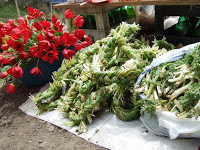Reader Devyn is looking for a bread recipe called bokon (boccone). The spelling might not be exact, so searching through cookbooks and the internet has been a bit challenging. I am turning this search to you, dear friends, hoping one of you can help satisfy Devyn’s request – and my curiosity. Thanks!
Devyn wrote:
“Hi Robyn!
I just found your blog and love it! I thought, knowing so much about Armenian food, perhaps you could help me with a search I’ve been on for a while.
Growing up, my grandfather would go to the Armenian delis around Los Angeles frequently and would always come back with bread my family called boccone. (I could very well be spelling that incorrectly!) I’ve been trying to find a recipe for it, but with no luck. It was definitely not choreg, I know that much (because we had that as well), but came shaped in a large rectangle, was about 1 ½ inches thick perhaps, and was “pillowy/quilted” in shape on the top, something akin to that sweet King’s Hawaiian bread. Do you know what I’m talking about? It wasn’t a sweet bread by any means, nor does it resemble the Italian boccone I found doing an internet search; it was something we often paired with chechil when we were a bit fatigued with having lavash.
I’m hoping you can help or send me in another helpful direction.
Best,
Devyn Egigian”
Robyn’s Comment:
To date I have not found a recipe, but I did find out the following about the bread from the book “Armenian Food” by Irina Petrosian and David Underwood:
“Bokon” is a small, round bread, thicker than lavash; also called pombi or prooz. Bokon requires a strong wood fire so is preferred in regions where there are forests, and it’s preparation is more demanding than lavash.
PS: “Chechil” is a mozzarella-like string cheese.
To assist in my search, I wrote to Ara Kassabian, who lives in LA, and Dorothy Arakelian, author of the Armenian cookbook, “Come Into My Kitchen” to ask if they knew of this bread.
Here is what Ara said:
“Sorry to say I’ve never heard of this bread. There are six types of bread commonly sold in the Armenian bakeries and markets here: pita bread, lavash (or one of its derivatives), matnakash, puri, barbari, and khachapuri. The last four are basically variants of each other. The matnakash is a large oval foccaccia-type bread with a furrow pattern in the top (you are probably familiar with this one). The barbari is basically a thinner, longer version of the matnakash but sprinkled with sesame seeds. The puri is basically a matnakash without the furrows, just a line down the center (probably made with a knife). The khachapuri (or at least I think that is what it is called) is a round, thin matnakash with a checkerboard pattern, about the size of a large pizza.
Besides these five types of breads, you have the crackers and so forth, but I’ve never heard of boccone or pombi.
As far as ingredients, all of these breads are made with flour, water, yeast, and salt (except for the lavash, of course, which does not use yeast). Extremely simple. I am assuming, therefore that the boccone is made the same way.”
Dorothy wrote:
“I’ll try to help you w/this recipe, best I can: First of all we both know that depending on which village or quel the parents or grandparents came from we refer to recipes by various names. With that said, I never heard the word “chechil” but from the description of her bread it sounds very much like what the Arabkirsees called “gagulth hatz” which is on page 63 of my book. Her description of pillowly/quilted on top and 1-1/2″ thick fits our gagulth hatz to a tea.
Whenever our families and friends were going to a picnic at the church or somewhere my Mother would bake this very early in the a.m. so we could take it to the picnic fresh and warm. And like she described, after baking it is thick and the pillowly effect comes from before baking, smearing a beaten egg on top with the five fingers poking indentations, thus the pillowly effect. It’s usually eaten w/cheese, etc., is long and rectangular in shape, very thick, soft and delicious. As a matter of fact, if you look at the cover of my book I have two of them standing up on the right hand side (right behind the choeregs). This was one of my Mother’s signature breads, as many people did not make it, in fact many people did not make lots of things my Mother made.”
There you have it. If any of you can help find a recipe for bokon, please email it to robyn@thearmeniankitchen.com. In the meantime, our search continues!
Recipe Search: “Bokon”, a thicker version of Lavash
(Visited 173 times, 1 visits today)




good information
Good enough for me to look for your cookbook.
That's great! Dorothy will be very pleased. The recipe will appear in tomorrow's blog, as well as where to purchase her cookbook.